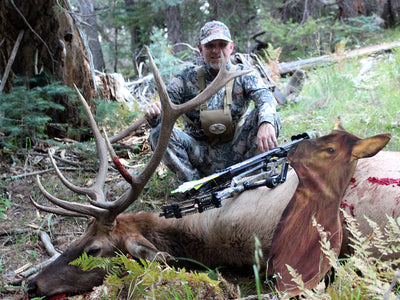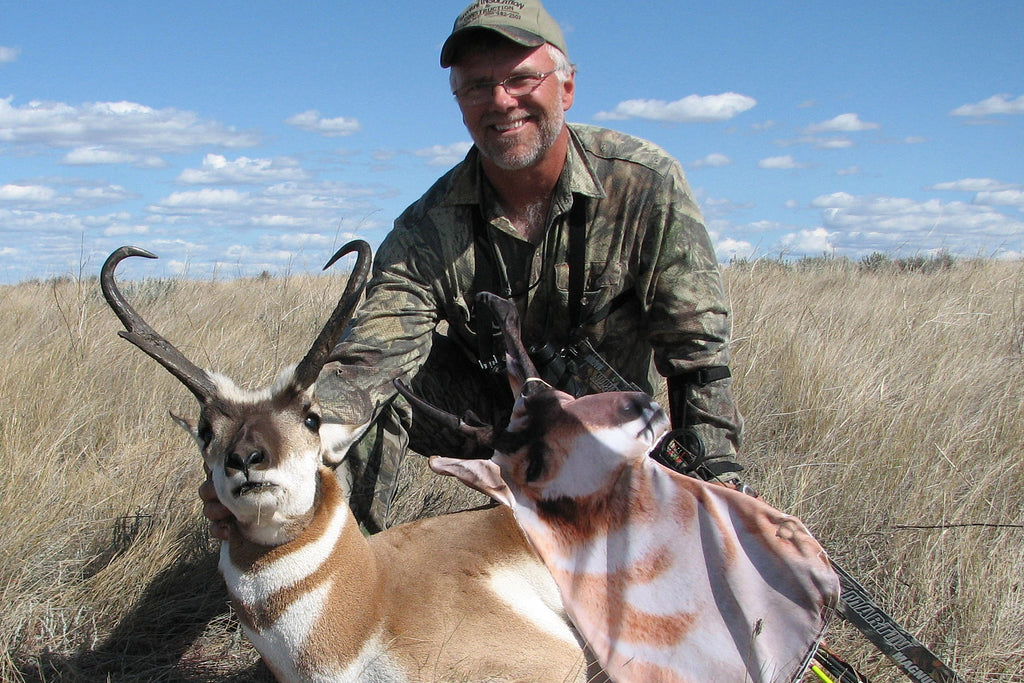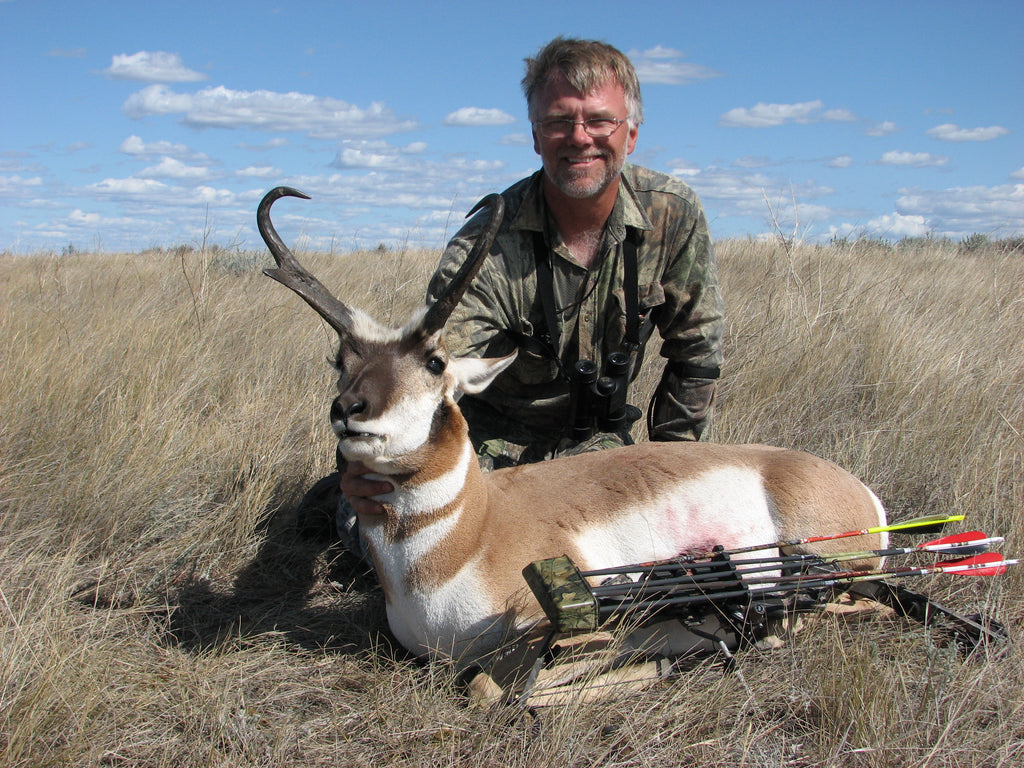Heads Up Decoy: A Quest for Montana Pronghorn Antelope
The early morning sky was black as I parked my pickup and started the mile-long hike to my blind. I rattled and clanked as I walked… the gear I was carrying didn’t make for a silent sneak to a stock watering pond I had discovered several years before. As the morning light began to shine I located a herd of pronghorn. I attempted a stalk close on the moving herd when they suddenly disappeared down a deep draw on the Montana prairie. Crawling around the side of a knoll, I found them busily drinking their fill next to my blind, the does all tanking up while the buck was on the lookout for any competition for his harem. He didn’t see any other pronghorn bucks, but he spotted me easily enough. As quickly as the stalk began, it was over. I spent the remainder of the day in the blind with no action.

Tips for Bowhunting Pronghorn Antelope: A breakdown of the Season
I’ve found that when hunting pronghorn antelope with a bow and arrow, there are several “seasons” within the usual antelope archery season, which in Montana runs August 15 to the second Sunday in October. The first season starts at opening day, and lasts until the end of the first week in September. The dog days of summer are the times where I’ve had my best luck sitting in blinds over watering holes, because the weather is generally very hot and very dry. Find a place where the antelope water frequently, and sooner or later they will return to it. I’ve heard of placing a blind in the morning and taking a pronghorn from it that afternoon, but that is unusual. I like to let them get used to the blind for a few days before hunting it. Stalking into the blind quietly in the dark seems to work best, and hopefully you’ll be able to set it up downwind of where the tracks indicate the most watering activity. After you get in the blind, it is simply a waiting game.
The second season is the time during the antelope rut, which peaks around mid-September. Using a decoy of some kind during the two middle weeks of September can produce some of the most thrilling bowhunting action you’ll ever see. Watching a mature, territorial pronghorn buck sprint at you as hard as he can is a sight you won’t soon forget!
It pays to keep out of sight for as long as possible before exposing your decoy. If the antelope sees your vehicle, sees you walking, or if you skyline yourself, you’re usually wasting your time trying to coax a mature buck within bow range. What works for me is to park my vehicle below the crest of a hill and walk up to it with my binoculars. I’ll scope out the area ahead of me before I move through it. If I see a pronghorn buck that looks feisty, I’ll figure out a way to slip up on him, hopefully closing within 200 yards before raising up the antelope decoy.
After the rut, waterhole hunts in blinds again get the nod, depending on the weather. Late September- early October can still be very hot and dry on the plains, and a patient sit over a waterhole is still effective.
Of course, anytime the antelope archery season is open is spot and stalk season. This is a very exciting method of hunting pronghorns, and works well if you’re in good shape for hiking and crawling through sagebrush and cactus, and also if you’re able to make slightly longer shots. Forty to fifty yards is not an uncommon distance for a bow shot on the prairie, because of the lack of cover. You’ll have many opportunities at longer shots, but these should be avoided because the chance of the animal moving is great, and also the typically strong winds can really affect arrow flight. If a bowhunter is patient, one can usually utilize breaks in the terrain to close the distance to within 40 yards, and make an ethical shot. Traditional bowhunters, with their ingrained and required discipline and patience, often get opportunities much closer than that.

As the season wore on with no success from the blind, it was time to transition to the next phase of the season. Seeing some good pronghorn bucks from my blind in the early season, so I saw no reason to venture too far from the same area to try decoying one. I’ve been decoying antelope for years, and I have several decoys in my arsenal, however this year I was particularly excited to try a decoy I had recently acquired. I was the editor of the Montana Bowhunters Association’s quarterly magazine at the time, and I had sold advertisement space to a small business named Heads Up Decoys, out of Kansas. I figured that we should support the businesses that support us, so I bought one of their antelope decoys. It was a photo-image on a foldable frame and could attach to my stabilizer. That way I wouldn’t have to worry about shoving the decoy stake in the baked earth, and I could hunt solo.
Getting a late start to on this September day, I made my way out to antelope country, leaving the blacktop and weaving my way down first gravel, then dirt roads to my hunting destination. Not long after arriving, I immediately picked out a lone antelope and I could tell right away that it was distracted…something was bothering it. Closer inspection showed a coyote was hassling the antelope buck, and also that the buck was large enough to require more scrutiny on my part. The coyote wasn’t doing much more than irritating the pronghorn, but that distraction was enough for me to drive my pickup to top of the hill so that I could put my spotting scope on the little drama. The ‘yote was just being a pain, and I could tell that the antelope, while mature, wasn’t quite what I wanted. Still, I had a brand new decoy to try out, so I backed off the crest of the hill and took a long hike around the gentle rise in front of me. I discovered a narrow cut in the prairie that took me within 300 yards of the buck, but I still wanted to get closer before I showed the decoy. There was no real cover, so I got down on my 52 year-old belly, and went to work.
I’ve always been surprised at how well my body responds to the demands I give it. Again, in spite of the time spent being a couch potato, I was able to crawl to a little fold in the prairie, and after relocating the buck, I slowly raised the decoy attached to my bow.
Nothing happened. Not only did the buck not see me, but the gusty crosswinds made it almost impossible to hold my bow/decoy steady. But that soon worked to my advantage, because nothing is more noticeable than movement. My decoy caught the attention of the buck, and he wasted no time. In less time than it takes to tell about it, he was 50 yards away and closing fast. I came to full draw, and held it when he crested a small hill 30 yards away. But he was head on, so there was no shot. The crosswind made it difficult to hold steady, so I passed on the shot and watched him turn and walk out of my life. When I had a little more hill between me and the buck, I scuttled to the top of the little prairie ripple and displayed the decoy once more.
I was surprised at how much he didn’t seem to care about the interloper in his area. Then I noticed that he wasn’t even looking in my direction. I looked over my shoulder and saw a good, wide pronghorn buck flying across the prairie, heading towards the antelope in front of me. I spun around, and displayed my decoy as largely as I could. It felt weird, shoving my compound up and waving it around, but it felt right.
It worked. The wide-horned buck ran by the buck I’d just decoyed, gracing him with barely a glance. He turned, and ran right to me. He stopped broadside at 35 yards, and I released. It was a good hit! The buck sprinted up the hell. I could see blood coming out of his chest, and I knew it was over. He made the top of the hill, and went down.
Already on my knees… I threw my head back, raised my hands and my bow to the sky and let out a primal, but silent, roar. If I’d had given voice to that roar, it probably would have carried to Canada, but to bellow it out would have been rude, somehow. I had just taken something’s life…I must show it respect. I thanked Christ. I thanked my wife, my kids, and my health. When I ran out of things to thank, I powered up my cell phone and called a couple friends, and shared, in excruciating detail, my experience.
I celebrated the clean kill, the mature buck, the addition of some tasty back straps to my freezer, and the conclusion to my Seasons in the Sun. I had spent a total of one hour and 40 minutes decoying antelope. After the many hours and days I had spent in my blind, you would think that I’d give up waterhole blind hunting forever, and concentrate on just hunting during the rut. That isn’t going to happen. Decoying pronghorns is far from a guaranteed shot opportunity. I had simply stumbled over an antelope buck in the mood to fight. Also, why would I cheat myself of hours of mental peace and communion with nature just for a chance at a quick kill? 21st century life is a busy hassle, and when we have an excuse to escape it, we’d better take it, every chance we have. The moment of truth is why we hunt… the quiet times are what make us whole.
Steve Sukut



